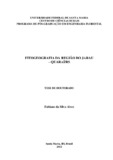| dc.creator | Alves, Fabiano da Silva | |
| dc.date.accessioned | 2013-03-19 | |
| dc.date.available | 2013-03-19 | |
| dc.date.issued | 2012-06-25 | |
| dc.identifier.citation | ALVES, Fabiano da Silva. Phytogeography of Jarau region - municipality of Quarai, Rio Grande do Sul state/Brazil. 2012. 103 f. Tese (Doutorado em Recursos Florestais e Engenharia Florestal) - Universidade Federal de Santa Maria, Santa Maria, 2012. | por |
| dc.identifier.uri | http://repositorio.ufsm.br/handle/1/3748 | |
| dc.description.abstract | Despite its reputation in southern Brazilian culture, the region of Jarau stills few known on the scientific point of view, raving contradictory opinions also about its geomorphology. Regarding to the regional flora, there is a remarkable diversity compared to the rest of the Campanha‟s Plateau, a fact that can be explained by different environments due to relief variations, the rock substratum, and differences on soils and water availability, in favor of habitat differentiation and a correspondent high number of endemic, rare or endangered plant species. The study was conducted in a polygon of 135,16 km2, bordered on the north by Garupá stream, on the south by Quaraí-Mirim stream, and to east and west by imaginary lines corresponding to the longitudes of 56º 28' 39" E and 56º 35' 26" W. Two hundred and seventy six plant species were found in this area, from 62 botanical families, including 64 endemic, rare and/or endangered species. Six types of natural vegetation were recognized in the region, based on physiognomic, floristic and phytoecological parameters: volcanic hill fields, sandstone hill fields, rupestrian fields, riparian forests, isolated group of trees in the midst of open fields, and Inhanduvá Park. Phytogeograpic maps and photos of distinct plants were provided to each recognized type of vegetation. The regional phytogeography recommends include all the studied area in the Uruguayense district of the Pampean Province (sensu Cabrera & Willink), despite the large floristic contribution from the adjoining Chaco, Espinal and Paranense provinces. At last, it is recommended the adoption of decisions toward the protection of the valuable natural patrimony of Jarau region. | eng |
| dc.format | application/pdf | por |
| dc.language | por | por |
| dc.publisher | Universidade Federal de Santa Maria | por |
| dc.rights | Acesso Aberto | por |
| dc.subject | Fitogeografia | por |
| dc.subject | Vegetação natural | por |
| dc.subject | Região do Jarau | por |
| dc.subject | Quaraí/RS | por |
| dc.subject | Phytogeography | eng |
| dc.subject | Natural vegetation | eng |
| dc.subject | Jarau region | eng |
| dc.subject | Municipality of Quaraí Rio Grande do Sul state/Brazil | eng |
| dc.title | Fitogeografia da região do Jarau - Quaraí/RS | por |
| dc.title.alternative | Phytogeography of Jarau region - municipality of Quarai, Rio Grande do Sul state/Brazil | eng |
| dc.type | Tese | por |
| dc.description.resumo | Apesar de seu renome na cultura sulina, a região do Jarau ainda é pouco conhecida sob o ponto de vista científico, não faltando, inclusive, opiniões contraditórias a respeito de sua geomorfologia. No tocante à flora regional, ali se encontra uma notável diversidade, comparada ao restante do Planalto da Campanha, fato que se explica pelos distintos ambientes gerados pela variação do relevo, do substrato rochoso, dos solos e da disponibilidade hídrica, em favor da diferenciação de habitats e de uma correspondente riqueza de espécies vegetais endêmicas, raras e/ou ameaçadas de extinção. A pesquisa foi desenvolvida em um polígono de 135,16 km2, limitado ao norte pelo arroio Garupá, ao sul pelo arroio Quaraí-Mirim, e a leste e oeste por linhas imaginárias correspondentes às longitudes de 56º 28' 39" L e 56º 35' 26" W. Nesta área foram encontradas 276 espécies de plantas superiores, pertencentes a 62 famílias botânicas, incluindo 64 espécies endêmicas, raras e/ou ameaçadas de extinção. Foram reconhecidas seis tipologias de vegetação natural, com base em parâmetros fisionômicos, florísticos e fitoecológicos: campos de colinas vulcânicas, campos em colinas de arenito, campos rupestres, matas ciliares, capões-de-mato e parque de inhanduvá. Para as distintas tipologias foram elaborados mapas fitogeográficos e pranchas ilustrativas, com fotos. A fitogeografia recomenda incluir a região em estudo no distrito Uruguayense e Província Pampeana (sensu Cabrera & Willink), apesar do numeroso aporte florístico de elementos chaquenhos, do Espinal e da Floresta Estacional (Província Paranense) em sua estrutura. Por fim, recomenda-se a adoção de medidas com vistas à proteção do valioso patrimônio natural existente na região do Jarau. | por |
| dc.contributor.advisor1 | Marchiori, José Newton Cardoso | |
| dc.contributor.advisor1Lattes | http://lattes.cnpq.br/2625842621787406 | por |
| dc.contributor.referee1 | Muniz, Graciela Ines Bolzon de | |
| dc.contributor.referee1Lattes | http://lattes.cnpq.br/4038930548278283 | por |
| dc.contributor.referee2 | Oliveira-deble, Anabela Silveira de | |
| dc.contributor.referee2Lattes | http://lattes.cnpq.br/6414574202534041 | por |
| dc.contributor.referee3 | Bressan, Delmar Antonio | |
| dc.contributor.referee3Lattes | http://lattes.cnpq.br/7063410848796405 | por |
| dc.contributor.referee4 | Trentin, Romario | |
| dc.contributor.referee4Lattes | http://lattes.cnpq.br/2287005710639329 | por |
| dc.creator.Lattes | http://lattes.cnpq.br/7487673550860949 | por |
| dc.publisher.country | BR | por |
| dc.publisher.department | Recursos Florestais e Engenharia Florestal | por |
| dc.publisher.initials | UFSM | por |
| dc.publisher.program | Programa de Pós-Graduação em Engenharia Florestal | por |
| dc.subject.cnpq | CNPQ::CIENCIAS AGRARIAS::RECURSOS FLORESTAIS E ENGENHARIA FLORESTAL | por |


